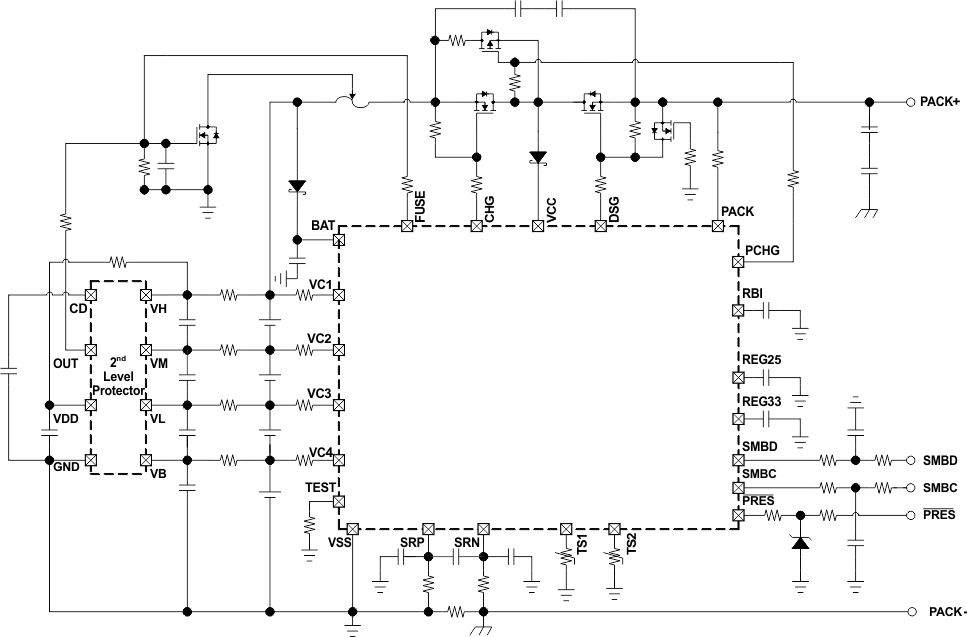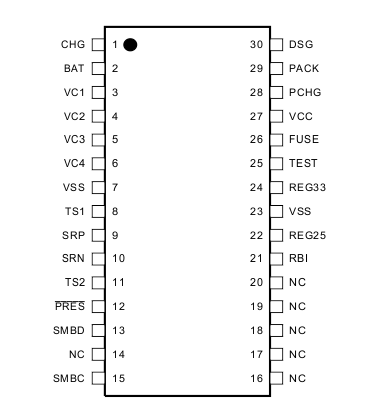-
bq3055 CEDV Gas Gauge and Battery Pack Manager for 2-Series, 3-Series, and 4-Series Li-Ion Batteries
- 1 Features
- 2 Applications
- 3 Description
- 4 Revision History
- 5 Pin Configuration and Functions
-
6 Specifications
- 6.1 Absolute Maximum Ratings
- 6.2 ESD Ratings
- 6.3 Recommended Operating Conditions
- 6.4 Thermal Information
- 6.5 Electrical Characteristics: Supply Current
- 6.6 Power-On Reset (POR)
- 6.7 Wake From Sleep
- 6.8 RBI RAM Backup
- 6.9 3.3-V Regulator
- 6.10 2.5-V Regulator
- 6.11 PRES, SMBD, SMBC
- 6.12 CHG, DSG FET Drive
- 6.13 PCHG FET Drive
- 6.14 FUSE
- 6.15 Coulomb Counter
- 6.16 VC1, VC2, VC3, VC4
- 6.17 TS1, TS2
- 6.18 Internal Temperature Sensor
- 6.19 Internal Thermal Shutdown
- 6.20 High-Frequency Oscillator
- 6.21 Low-Frequency Oscillator
- 6.22 Internal Voltage Reference
- 6.23 Flash
- 6.24 OCD Current Protection
- 6.25 SCD1 Current Protection
- 6.26 SCD2 Current Protection
- 6.27 SCC Current Protection
- 6.28 SBS Timing Requirements
- 6.29 Typical Characteristics
- 7 Parameter Measurement Information
- 8 Detailed Description
- 9 Application and Implementation
- 10Power Supply Recommendations
- 11Layout
- 12Device and Documentation Support
- 13Mechanical, Packaging, and Orderable Information
- IMPORTANT NOTICE
Package Options
Mechanical Data (Package|Pins)
- DBT|30
Thermal pad, mechanical data (Package|Pins)
Orderable Information
bq3055 CEDV Gas Gauge and Battery Pack Manager for 2-Series, 3-Series, and 4-Series Li-Ion Batteries
1 Features
- Fully Integrated 2-Series, 3-Series, and 4-Series Li-Ion or Li-Polymer Cell Battery Pack Manager and Protection
- Advanced Compensated End-of-Discharge Voltage (CEDV) Gauging
- High-Side N-CH Protection FET Drive
- Integrated Cell Balancing
- Low-Power Modes
- Low Power: < 180 µA
- Sleep < 76 µA
- Full Array of Programmable Protection Features
- Voltage
- Current
- Temperature
- Sophisticated Charge Algorithms
- JEITA
- Enhanced Charging
- Adaptive Charging
- Supports Two-Wire SMBus v1.1 Interface
- SHA-1 Authentication
- Compact Package: 30-Lead TSSOP
2 Applications
- Notebook and Netbook PCs
- Medical and Test Equipment
- Portable Instrumentation
3 Description
The bq3055 device is a fully integrated, single-chip, pack-based solution that provides a rich array of features for gas gauging, protection, and authentication for 2-series, 3-series, and 4-series cell Li-Ion and Li-Polymer battery packs.
Using its integrated high-performance analog peripherals, the bq3055 device measures and maintains an accurate record of available capacity, voltage, current, temperature, and other critical parameters in Li-Ion or Li-Polymer batteries, and reports this information to the system host controller over an SMBus v1.1 compatible interface.
The bq3055 provides software-based 1st-level and 2nd-level safety protection for overvoltage, undervoltage, overtemperature, and overcharge conditions, as well as hardware-based protection for overcurrent in discharge and short circuit in charge and discharge conditions.
SHA-1 authentication with secure memory for authentication keys enables identification of genuine battery packs beyond any doubt.
The compact 30-lead TSSOP package minimizes solution cost and size for smart batteries while providing maximum functionality and safety for battery gauging applications.
Device Information(1)
| PART NUMBER | PACKAGE | BODY SIZE (NOM) |
|---|---|---|
| bq3055 | TSSOP (30) | 7.80 mm × 4.40 mm |
- For all available packages, see the orderable addendum at the end of the data sheet.
Simplified Schematic

4 Revision History
Changes from B Revision (October 2013) to C Revision
- Added ESD Ratings table, Feature Description section, Device Functional Modes, Application and Implementation section, Power Supply Recommendations section, Layout section, Device and Documentation Support section, Community Resources section, and Mechanical, Packaging, and Orderable Information section Go
- Changed SRP, SRN absolute maximum values Go
Changes from A Revision (June 2011) to B Revision
- Changed Electrical Characteristic for ICC ShutdownGo
5 Pin Configuration and Functions

Pin Functions
| PIN | TYPE(1) | DESCRIPTION | |
|---|---|---|---|
| NAME | NO. | ||
| BAT | 2 | P | Alternate power source |
| CHG | 1 | O | Charge N-FET gate drive |
| DSG | 30 | O | Discharge N-FET gate drive |
| FUSE | 26 | O | Fuse drive |
| NC | 14 | — | Not internally connected. Connect to VSS. |
| NC | 16 | — | Not internally connected. Connect to VSS. |
| NC | 17 | — | Not internally connected. Connect to VSS. |
| NC | 18 | — | Not internally connected. Connect to VSS. |
| NC | 19 | — | Not internally connected. Connect to VSS. |
| NC | 20 | — | Not internally connected. Connect to VSS. |
| PACK | 29 | P | Alternate power source |
| PCHG | 28 | I/OD | Precharge P-FET gate drive |
| PRES | 12 | I | Host system present input |
| RBI | 21 | P | RAM backup |
| REG25 | 22 | P | 2.5-V regulator output |
| REG33 | 24 | P | 3.3-V regulator output |
| SMBC | 15 | I/OD | SMBus v1.1 clock line |
| SMBD | 13 | I/OD | SMBus v1.1 data line |
| SRN | 10 | AI | Differential Coulomb Counter input |
| SRP | 9 | AI | Differential Coulomb Counter input |
| TEST | 25 | — | Test pin, connect to VSS through 2-kΩ resistor. |
| TS1 | 8 | AI | Temperature sensor 1 thermistor input |
| TS2 | 11 | AI | Temperature sensor 2 thermistor input |
| VC1 | 3 | I | Sense input for positive voltage of top most cell in stack and cell balancing input for top most cell in stack |
| VC2 | 4 | I | Sense input for positive voltage of third lowest cell in stack and cell balancing input for third lowest cell in stack |
| VC3 | 5 | I | Sense input for positive voltage of second lowest cell in stack and cell balancing input for second lowest cell in stack |
| VC4 | 6 | I | Sense input for positive voltage of lowest cell in stack and cell balancing input for lowest cell in stack |
| VCC | 27 | P | Power supply voltage |
| VSS | 7 | P | Device ground |
| VSS | 23 | P | Device ground |